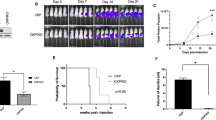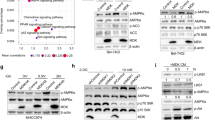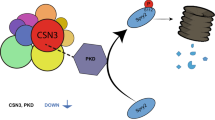Abstract
Pancreatic ductal adenocarcinoma (PDAC) cell lines, MIA PaCa-2, and UK Pan-1, were used to investigate the role of ErbB2 in PDAC oncogenesis. Both these cell lines exhibit exogenous growth factor-independent proliferation that was attributed to the production of autocrine growth factors and/or overexpression of growth factor receptors. The exogenous growth factor-independent phenotype displayed by these PDAC cell lines was dependent on ErbB2 kinase activity since treatment of cells with tyrphostin AG879 prevented serum-free media (SFM) induction of cell proliferation. We determined that ErbB2 kinase contributed to aberrant cell cycle regulation in PDAC through the induction of cyclin D1 levels and the suppression of p21Cip1 and p27Kip1. Inhibition of ErbB2 kinase led to cell cycle arrest marked by an increased association of p27Kip1 with cdk2 and reduced levels of phosphorylated pRb. We further observed constitutive STAT3 activation in the PDAC cell lines and an increase in STAT3 activation upon stimulating quiescent cells with SFM. Inhibitors of ErbB2 kinase blocked STAT3 activation, whereas inhibition of EGFR kinase led to a slight reduction of STAT3 activation. STAT3 was coimmunoprecipitated with ErbB2. SFM stimulation caused an increase in the association of ErbB2 and STAT3, which was blocked by inhibition of ErbB2 kinase. Expression of a STAT3 dominant negative prevented SFM-stimulated cell proliferation of MIA PaCa-2 cells, suggesting that activation of STAT3 by ErbB2 is required for a growth factor-independent phenotype of these cells. Consistent with this observation in PDAC cell lines, we found that most PDAC tumor specimens (10 of 11) showed constitutive activation of STAT3 and that ErbB2 was readily detected in most of these tumors (nine of 11). We believe that these findings indicate a novel mechanism of oncogenesis in PDAC and may suggest future therapeutic strategies in the treatment of PDAC.
This is a preview of subscription content, access via your institution
Access options
Subscribe to this journal
Receive 50 print issues and online access
$259.00 per year
only $5.18 per issue
Buy this article
- Purchase on Springer Link
- Instant access to full article PDF
Prices may be subject to local taxes which are calculated during checkout









Similar content being viewed by others
References
Albanese C, Johnson J, Watanabe G, Eklund N, Vu D, Arnold A and Pestell RG . (1995). J. Biol. Chem., 270, 23589–23597.
Allred DC, Clark GM, Molina R, Tandon AK, Schnitt SJ, Gilchrist KW, Osborne CK, Tormey DC and McGuire WL . (1992). Hum. Pathol., 23, 974–979.
Aziz N, Cherwinski H and McMahon M . (1999). Mol. Cell. Biol., 19, 1101–1115.
Bartkova J, Lukas J and Bartek J . (1997). Prog. Cell Cycle Res., 3, 211–220.
Basso AD, Solit DB, Munster, PN and Rosen N . (2002). Oncogene, 21, 1159–1166.
Bowman T, Garcia R, Turkson J and Jove R . (2000a). Oncogene, 19, 2474–2488.
Bowman T, Garcia R, Turkson J and Jove R . (2000b). Oncogene, 19, 2474–2488.
Bowman T, Broome MA, Sinibaldi D, Wharton W, Pledger WJ, Sedivy JM, Irby R, Yeatman T, Courtneidge SA and Jove R . (2001). Proc. Natl. Acad. Sci. USA, 98, 7319–7324.
Brennan PJ, Kumogai T, Berezov A, Murali R and Greene MI . (2000). Oncogene, 19, 6093–6101.
Burke WM, Jin X, Lin HJ, Huang M, Liu R, Reymaolds RK and Lin J . (2002). Oncogene, 20, 7925–7934.
Busse D, Doughty RS and Arteaga CL . (2000). Semin. Oncol., 27, 3–8, (discussion 92–100).
Caldenhoven E, van Dijk TB, Solari R, Armstrong J, Raaijmakers JAM, Lammers JWJ, Koenderman L and de Groot RP . (1996). J. Biol. Chem., 271, 13221–13227.
Catlett-Falcone R, Landowski T, Oshiro M, Turkson J, Levitzki A, Savino R, Ciliberto G, Moscinski L, Fernandez-Luna JL, Nunez G, Dalton W and Jove R . (1999). Immunity, 10, 105–115.
Cheng M, Sexl V, Sherr CJ and Roussel MF . (1998). Proc. Natl. Acad. Sci. USA, 95, 1091–1096.
Cheng M, Olivier P, Diehl JA, Fero M, Roussel MF, Roberts JM and Sherr CJ . (1999). EMBO J., 18, 1571–1583.
Chin YE, Kitagawa M, Su WC, You ZH, Iwamoto Y and Fu XY . (1996). Science, 272, 719–722.
Darnell Jr JE . (1997). Science, 277, 1630–1635.
Darnell Jr JE, Kerr IM and Stark GR . (1994). Science, 264, 1415–1421.
Diehl JA, Cheng M, Roussel MF and Sherr CJ . (1998). Genes De., 12, 3499–3511.
Di Fiore PP, Pierce JH, Fleming TP, Hazan R, Ullrich A, King CR, Schlessinger J and Aaronson SA . (1987). Cell, 51, 1063–1070.
Di Marco E, Pierce JH, Knicley CL and Di Fiore PP . (1990). Mol. Cell. Biol., 10, 3247–3252.
Dugan MC, Dergham ST, Kucway R, Singh K, Biernat L, Du W, Vaitkevicius VK, Crissman JD and Sarkar FH . (1997). Pancreas, 14, 229–236.
Fernandes A, Hamburger AW and Gerwin BI . (1999). Int. J. Cancer, 83, 564–570.
Fralix KD, Ahmed MM, Mattingly C, Swiderski C, McGrath PC, Venkatasubbarao K, Kamada N, Mohiuddin M, Strodel WE and Freeman JW . (2000). Cancer, 88, 2010–2021.
Freeman JW, Mattingly CA and Strodel WE . (1995). J. Cell. Physiol., 65, 155–163.
Friess H, Wang L, Zhu Z, Gerber R, Schroder M, Fukuda A, Zimmermann A, Korc M and Buchler MW . (1999). Ann. Surg., 230, 767–774, discussion 774–775.
Garcia R, Bowman TL, Niu G, Yu H, Minton S, Muro-Cacho CA, Cox CE, Falcone R, Fairclough R, Parsons S, Laudano A, Gazit A, Levitzki A, Kraker A and Jove R . (2001). Oncogene, 20, 2499–2513.
Gartel AL, Najmabadi F, Goufman E and Tyner AL . (2000). Oncogene, 19, 961–964.
Gjoerup O, Lukas J, Bartek J and Willumsen BM . (1998). J. Biol. Chem., 273, 18812–18818.
Grandis JR, Drenning SD, Chakraborty A, Zhou MY, Zeng Q, Pitt AS and Tweardy DJ . (1998). J. Clin. Invest., 102, 1385–1392.
Hall PA, Hughes CM, Staddon SL, Richman PI, Gullick WJ and Lemoine NR . (1990). J. Pathol., 161, 195–200.
Harari D and Yarden Y . (2000). Oncogene, 19, 6102–6114.
Howell GM, Humphrey LE, Awwad RA, Wang D, Koterba A, Periyasamy B, Yang J, Li W, Willson JK, Ziober BL, Coleman K, Carboni J, Lynch M and Brattain MG . (1998a). J. Biol. Chem., 273, 9214–9223.
Howell GM, Humphrey LE, Ziober BL, Awwad R, Periyasamy B, Koterba A, Li W, Willson JK, Coleman K, Carboni J, Lynch M and Brattain MG . (1998b). Mol. Cell. Biol., 18, 303–313.
Hung MC, Yan DH and Zhao XY . (1989). Proc. Natl. Acad. Sci. USA, 86, 2545–2548.
Hynes NE and Stern DF . (1994). Biochim. Biophys. Acta, 1198, 165–184.
Ihle JN, Witthuhn BA, Quelle FW, Yamamoto K and Silvennoinen O . (1995). Annu. Rev. Immunol., 13, 369–398.
Ihle JN . (1996). Cell, 84, 331–334.
Jaskiewicz K, Krige JE and Thomson J . (1994). Anticancer Res., 14, 1919–1922.
Jiang D, Yang H, Willson JK, Liang J, Humphrey LE, Zborowska E, Wang D, Foster J, Fan R and Brattain MG . (1998a). J. Biol. Chem., 273, 31471–31479.
Jiang D, Liang J, Humphrey LE, Yang H and Brattain MG . (1998b). J. Cell. Physiol., 175, 174–183.
Klapper LN, Kirschbaum MH, Sela M and Yarden Y . (2000). Adv. Cancer Res., 77, 25–79.
Kloppel G, Lingenthal G, von Bulow M and Kern HF . (1985). Histopathology, 9, 841–856.
Kiuchi N, Nakajima K, Ichiba M, Fukada T, Narimatsu M, Mizuno K, Hibi M and Hirano T . (1999). J. Exp. Med., 189, 63–73.
Kokai Y, Myers JN, Wada T, Brown VI, LeVea CM, Davis JG, Dobashi K and Greene MI . (1989). Cell, 58, 287–292.
Korc M, Chandrasekar B, Yamanaka Y, Friess H, Buchier M and Beger HG . (1992). J. Clin. Invest., 90, 1352–1360.
LaBaer J, Garrett MD, Stevenson LF, Slingerland JM, Sandhu C, Chou HS, Fattaey A and Harlow E . (1997). Genes Dev., 11, 847–862.
Leaman DW, Leung S, Li X and Stark GR . (1996a). FASEB J., 10, 1578–1588.
Leaman DW, Pisharody S, Flickinger TW, Commane MA, Schlessinger J, Kerr IM, Levy DE and Stark GR . (1996b). Mol. Cell. Biol., 16, 369–375.
Lee RJ, Albanese C, Fu M, D’Amico M, Lin B, Watanabe G, Haines III GK, Siegel PM, Hung MC, Yarden Y, Horowitz JM, Muller WJ and Pestell RG . (2000). Mol. Cell. Biol., 20, 672–683.
Levitzki A and Gazit A . (1995). Science, 267, 1782–1788.
Mack L, Kerkvliet N, Doig G and O’Malley FP . (1997). Hum. Pathol., 28, 974–979.
Masuda M, Suzui M, Yasumatu R, Nakashima T, Kuratomi T, Azuma K, Tomita K, Komiyama S and Weinstein IB . (2002). Cancer Res., 62, 3351–3355.
Ohmichi M, Pang L, Ribon V, Gazit A, Levitzki A and Saltiel AR . (1993). Biochemistry, 32, 4650–4658.
Olayioye MA, Beuvink I, Horsch K, Daly JM and Hynes NE . (1999). J. Biol. Chem., 274, 17209–17218.
Osherov N, Gazit A, Gilon C and Levitzki A . (1993). J Biol. Chem., 268, 11134–11142.
Satoh K, Sasano H, Shimosegawa T, Koizumi M, Yamazaki T, Mochizuki F, Kobayashi N, Okano T, Toyota T and Sawai T . (1993). Cancer, 72, 51–56.
Schaefer LK, Ren Z, Fuller GN and Schafer TS . (2002). Oncogene, 21, 2058–2065.
Seidel HM, Milocco LH, Lamb P, Darnell Jr JE, Stein RB and Rosen J . (1995). Proc. Natl. Acad. Sci. USA, 92, 3041–3045.
Sherr CJ and Roberts JM . (1999). Genes Dev., 13, 1501–1512.
Sinibaldi D, Wharton W, Turkson J, Bowman T, Pledger WJ and Jove R . (2000). Oncogene, 19, 5419–5427.
Somerville JE, Clarke LA and Biggart JD . (1992). J. Clin. Pathol., 45, 16–20.
Sporn MB and Roberts AB . (1985). Nature, 313, 745–747.
Sporn MB and Todaro GJ . (1980). N. Engl. J. Med., 303, 878–880.
Weinstat-Saslow D, Merino MJ, Manrow RE, Lawrence JA, Bluth RF, Wittenbel KD, Simpson JF, Page DL and Steeg PS . (1995). Nat. Med., 1, 1257–1260.
Worsley SD, Ponder BA and Davies BR . (1997). Gynecol. Oncol., 64, 189–195.
Xiong Y, Hannon GJ, Zhang H, Casso D, Kobayashi R and Beach D . (1993). Nature, 366, 701–704.
Yamanaka Y, Friess H, Kobrin MS, Buchler M, Kunz J, Beger HG and Korc M . (1993). Hum. Pathol., 24, 1127–1134.
Yeh TC and Pellegrini S . (1999). Cell. Mol. Life Sci., 55, 1523–1534.
Zhang H, Hannon GJ and Beach D . (1994). Genes Dev., 8, 1750–1758.
Ziober BL, Willson JK, Hymphrey LE, Childress-Fields K and Brattain MG . (1993). J. Biol. Chem., 268, 691–698.
Acknowledgements
This work was supported by a San Antonio Cancer Institute Core Grant P30 CA 54174 and by NIH-RO1 Grant CA69122 to JWF. We thank Dr Richard Jove, Moffitt Cancer Center at the University of South Florida, Tampa, FL, for providing us with the STAT3β construct and for helpful discussion regarding the use of this construct.
Author information
Authors and Affiliations
Corresponding author
Rights and permissions
About this article
Cite this article
DeArmond, D., Brattain, M., Jessup, J. et al. Autocrine-mediated ErbB-2 kinase activation of STAT3 is required for growth factor independence of pancreatic cancer cell lines. Oncogene 22, 7781–7795 (2003). https://doi.org/10.1038/sj.onc.1206966
Received:
Revised:
Accepted:
Published:
Issue Date:
DOI: https://doi.org/10.1038/sj.onc.1206966
Keywords
This article is cited by
-
Mesothelin blockage by Amatuximab suppresses cell invasiveness, enhances gemcitabine sensitivity and regulates cancer cell stemness in mesothelin-positive pancreatic cancer cells
BMC Cancer (2021)
-
Inhibiting signal transducer and activator of transcription-3 increases response to gemcitabine and delays progression of pancreatic cancer
Molecular Cancer (2013)
-
Differential roles of cyclin D1 and D3 in pancreatic ductal adenocarcinoma
Molecular Cancer (2010)
-
Activity of a novel, dual PI3-kinase/mTor inhibitor NVP-BEZ235 against primary human pancreatic cancers grown as orthotopic xenografts
British Journal of Cancer (2009)
-
Immunohistochemical analysis of changes in signaling pathway activation downstream of growth factor receptors in pancreatic duct cell carcinogenesis
BMC Cancer (2008)



